Effect of Different Weight on the Movable PZT Device on the Damage Detection Performance of Electromechanical Impedance Technique
Abstract
:1. Introduction
2. Electromechanical Impedance Technique
2.1. The Electromechanical Impedance Technique
2.2. Experimental Setup
3. Development of the Impedance Measuring PZT Device
3.1. Related Work
3.2. Model of PZT Device
4. Performance of the PZT Device Subjected to Different Structure Thicknesses
4.1. Impedance Sigantures for a 0.2 mm Top Thickness Composite Structure
4.2. Impedance Signatures for a 0.6 mm Top Thickness Composite Structure
4.3. Analyses of Averaged Impedance Sigantures for 0.2 mm and 0.6 mm Top Plate Composites
5. Performance of the PZT Device Subjected to an Increase in Weight
5.1. Impedance Signature Analysis with Additional 50 g
5.2. Impedance Signature Analysis with an Additional 100 g
5.3. Averaged Signature Analysis of Additional 50 g and 100 g
5.4. Reliability Evaluation of the PZT Device Subjected to Different Weights
6. Discussion of Weight and Standard Deviation of the PZT Device
7. Conclusions
Author Contributions
Funding
Data Availability Statement
Conflicts of Interest
References
- Hsissou, R.; Seghiri, R.; Benzekri, Z.; Hilali, M.; Rafik, M.; Elharfi, A. Polymer composite materials: A comprehensive review. Compos. Struct. 2021, 262, 113640. [Google Scholar] [CrossRef]
- Zhao, G.; Wang, B.; Wang, T.; Hao, W.; Luo, Y. Detection and monitoring of delamination in composite laminates using ultrasonic guided wave. Compos. Struct. 2019, 225, 111161. [Google Scholar] [CrossRef]
- Wang, X.; Wang, Q.; Zhang, L.; Yu, J.; Liu, Q. Three-Dimensional Defect Characterization of Ultrasonic Detection Based on GCNet Improved Contrast Learning Optimization. Electronics 2023, 12, 3944. [Google Scholar] [CrossRef]
- Scarponi, C.; Briotti, G. Ultrasonic detection of delaminations on composite materials. J. Reinf. Plast. Compos. 1997, 16, 768–790. [Google Scholar] [CrossRef]
- Ghadermazi, K.; Khozeimeh, M.A.; Taheri-Behrooz, F.; Safizadeh, M.S. Delamination detection in glass–epoxy composites using step-phase thermography (SPT). Infrared Phys. Technol. 2015, 72, 204–209. [Google Scholar] [CrossRef]
- Moskovchenko, A.I.; Vavilov, V.P.; Bernegger, R.; Maierhofer, C.; Chulkov, A.O. Detecting delaminations in semitransparent glass fiber composite by using pulsed infrared thermography. J. Nondestruct. Eval. 2020, 39, 1–10. [Google Scholar] [CrossRef]
- Chrysafi, A.P.; Athanasopoulos, N.; Siakavellas, N.J. Damage detection on composite materials with active thermography and digital image processing. Int. J. Therm. Sci. 2017, 116, 242–253. [Google Scholar] [CrossRef]
- Saeedifar, M.; Zarouchas, D. Damage characterization of laminated composites using acoustic emission: A review. Compos. Part B Eng. 2020, 195, 108039. [Google Scholar] [CrossRef]
- Fotouhi, M.; Najafabadi, M.A. Acoustic emission-based study to characterize the initiation of delamination in composite materials. J. Thermoplast. Compos. Mater. 2016, 29, 519–537. [Google Scholar] [CrossRef]
- Silversides, I.; Maslouhi, A.; LaPlante, G. Acoustic emission monitoring of interlaminar delamination onset in carbon fibre composites. Struct. Health Monit. 2013, 12, 126–140. [Google Scholar] [CrossRef]
- Ni, Q.Q.; Hong, J.; Xu, P.; Xu, Z.; Khvostunkov, K.; Xia, H. Damage detection of CFRP composites by electromagnetic wave nondestructive testing (EMW-NDT). Compos. Sci. Technol. 2021, 210, 108839. [Google Scholar] [CrossRef]
- Dehui, W.; Fan, Y.; Teng, W.; Wenxiong, C. A novel electromagnetic nondestructive testing method for carbon fiber reinforced polymer laminates based on power loss. Compos. Struct. 2021, 276, 114421. [Google Scholar] [CrossRef]
- Wandowski, T.; Malinowski, P.H.; Ostachowicz, W.M. Delamination detection in CFRP panels using EMI method with temperature compensation. Compos. Struct. 2016, 151, 99–107. [Google Scholar] [CrossRef]
- Singh, S.K.; Soman, R.; Wandowski, T.; Malinowski, P. A variable data fusion approach for electromechanical impedance-based damage detection. Sensors 2020, 20, 4204. [Google Scholar] [CrossRef]
- Kim, Y.S.; Na, W.S. Implementation of biomimicry for detecting composite structure damage using impedance-based Non-destructive testing method. Appl. Sci. 2023, 13, 876. [Google Scholar] [CrossRef]
- Griffin, C.; Giurgiutiu, V. Piezoelectric Wafer Active Sensor Transducers for Acoustic Emission Applications. Sensors 2023, 23, 7103. [Google Scholar] [CrossRef]
- Wang, J.; Shen, Y. An enhanced Lamb wave virtual time reversal technique for damage detection with transducer transfer function compensation. Smart Mater. Struct. 2019, 28, 085017. [Google Scholar]
- Dipon, W.; Gamboa, B.; Guo, R.; Bhalla, A. Energy harvesting using a stacked PZT transducer for self-sustainable remote multi-sensing and data logging system. J. Compos. Sci. 2022, 6, 49. [Google Scholar] [CrossRef]
- Liang, C.; Sun, F.P.; Rogers, C.A. Coupled electro-mechanical analysis of adaptive material systems—determination of the actuator power consumption and system energy transfer. J. Intell. Mater. Syst. Struct. 1994, 5, 12–20. [Google Scholar]
- Singh, S.K.; Shanker, R. Determining the Sensing Region of Surface Bonded PZT Sensor and Surface Mounted PZT Sensor in Electro-Mechanical Impedance Technique for Non-Destructive Testing. Russ. J. Nondestruct. Test. 2022, 58, 934–949. [Google Scholar] [CrossRef]
- Singh, S.K.; Shanker, R.; Ranjan, A. Health Monitoring of Steel Structures Using Surface Mountable and Detachable PZT Sensor. J. Intell. Mater. Syst. Struct. 2024, 35, 380–392. [Google Scholar] [CrossRef]
- Liu, Q.; Chai, Y.; Wang, Y.; Sun, H.; Qing, X. Adhesively Bonding a Reusable PZT Transducer for Structural Health Monitoring (SHM) with an Ethylene-Acrylic Acid Copolymer Adhesive. Int. J. Adhes. 2022, 119, 103256. [Google Scholar] [CrossRef]
- Moharana, S.; Bhalla, S. Development and Evaluation of an External Reusable Piezo-Based Concrete Hydration-Monitoring Sensor. J. Intell. Mater. Syst. Struct. 2019, 30, 2770–2788. [Google Scholar] [CrossRef]
- Baral, S.; Adhikari, S.; Negi, P.; Bhalla, S. Development and Evaluation of Reusable Piezo Sensors for Health Monitoring of Thin-Walled Steel Structures. J. Civ. Struct. Health Monit. 2022, 12, 647–657. [Google Scholar] [CrossRef]
- Yang, Y.; Divsholi, B.S.; Soh, C.K. A Reusable PZT Transducer for Monitoring Initial Hydration and Structural Health of Concrete. Sensors 2010, 10, 5193–5208. [Google Scholar] [CrossRef]
- Divsholi, B.S.; Yang, Y. Application of Reusable PZT Sensors for Monitoring Initial Hydration of Concrete. Sens. Smart Struct. Technol. Civ. Mech. Aerosp. Syst. 2009, 7292, 698–706. [Google Scholar]
- Tawie, R.; Lee, H.-K. Characterization of Cement-Based Materials Using a Reusable Piezoelectric Impedance-Based Sensor. Smart Mater. Struct. 2011, 20, 085023. [Google Scholar] [CrossRef]
- Parpe, A.; Jothi Saravanan, T. New refined analytical models for various bonding conditions of an adhesively bonded smart PZT transducer using the EMI technique. Smart Mater. Struct. 2021, 30, 125015. [Google Scholar] [CrossRef]
- Saravanan, T.; Jothi, T.; Chauhan, S.S. Study on pre-damage diagnosis and analysis of adhesively bonded smart PZT sensors using EMI technique. Measurement 2022, 188, 110411. [Google Scholar] [CrossRef]
- Na, W.; Baek, J. Adhesive Defect Monitoring of Glass Fiber Epoxy Plate Using an Impedance-Based Non-Destructive Testing Method for Multiple Structures. Sensors 2017, 17, 1439. [Google Scholar] [CrossRef]
- Nguyen, C.H.; Pietrzko, S.; Buetikofer, R. The influence of temperature and bonding thickness on the actuation of a cantilever beam by PZT patches. Smart Mater. Struct. 2004, 13, 851. [Google Scholar] [CrossRef]
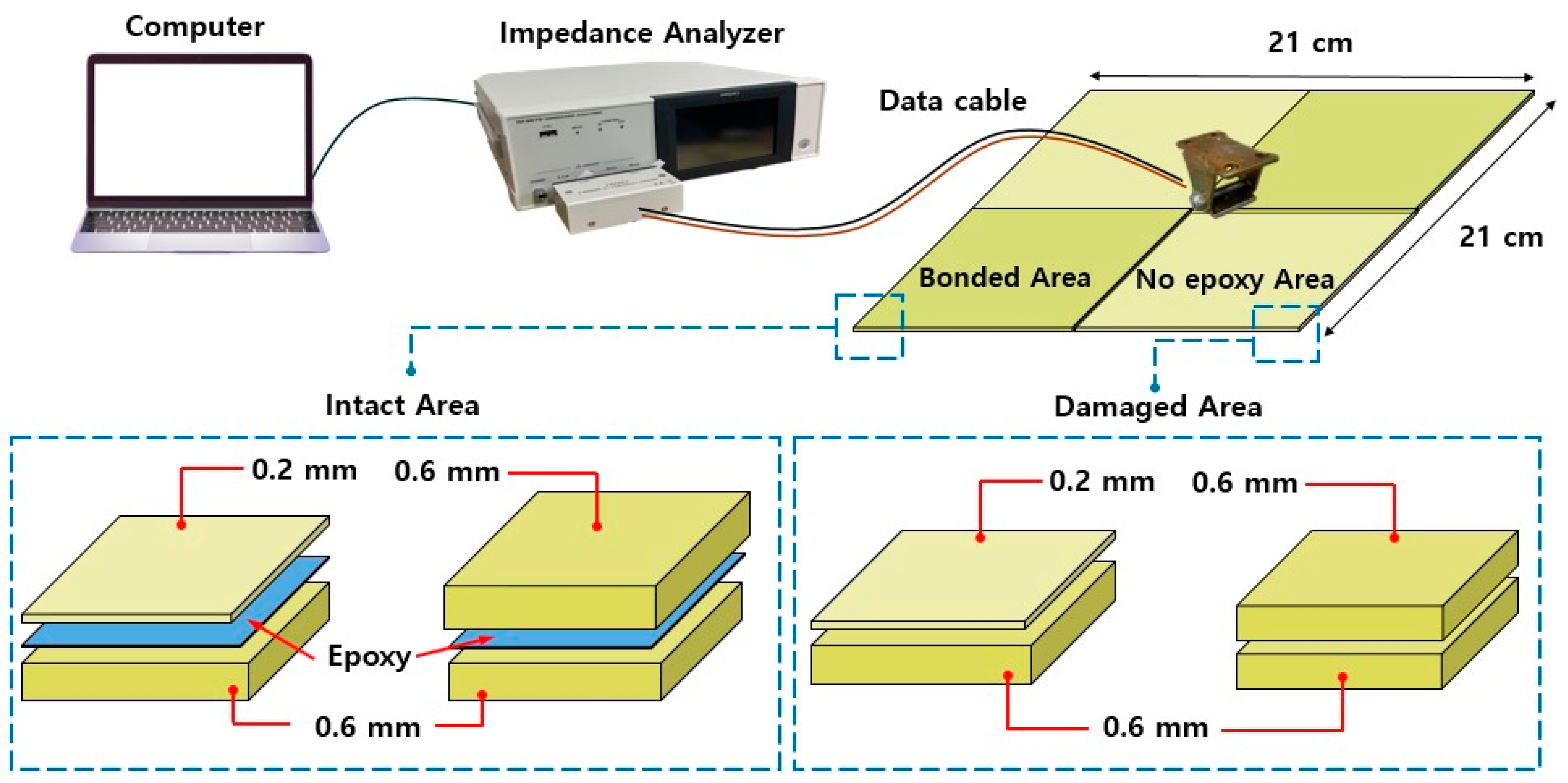

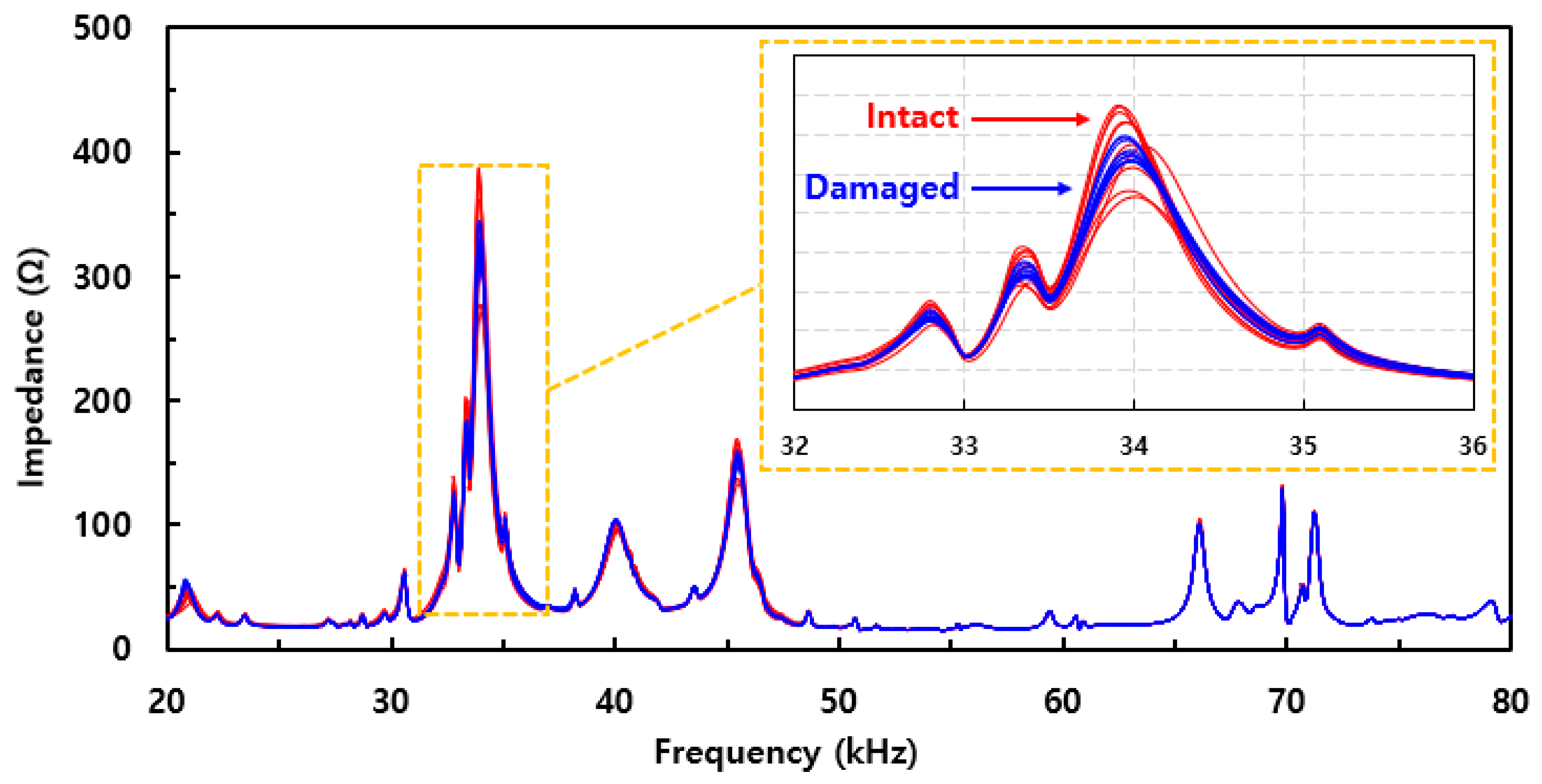

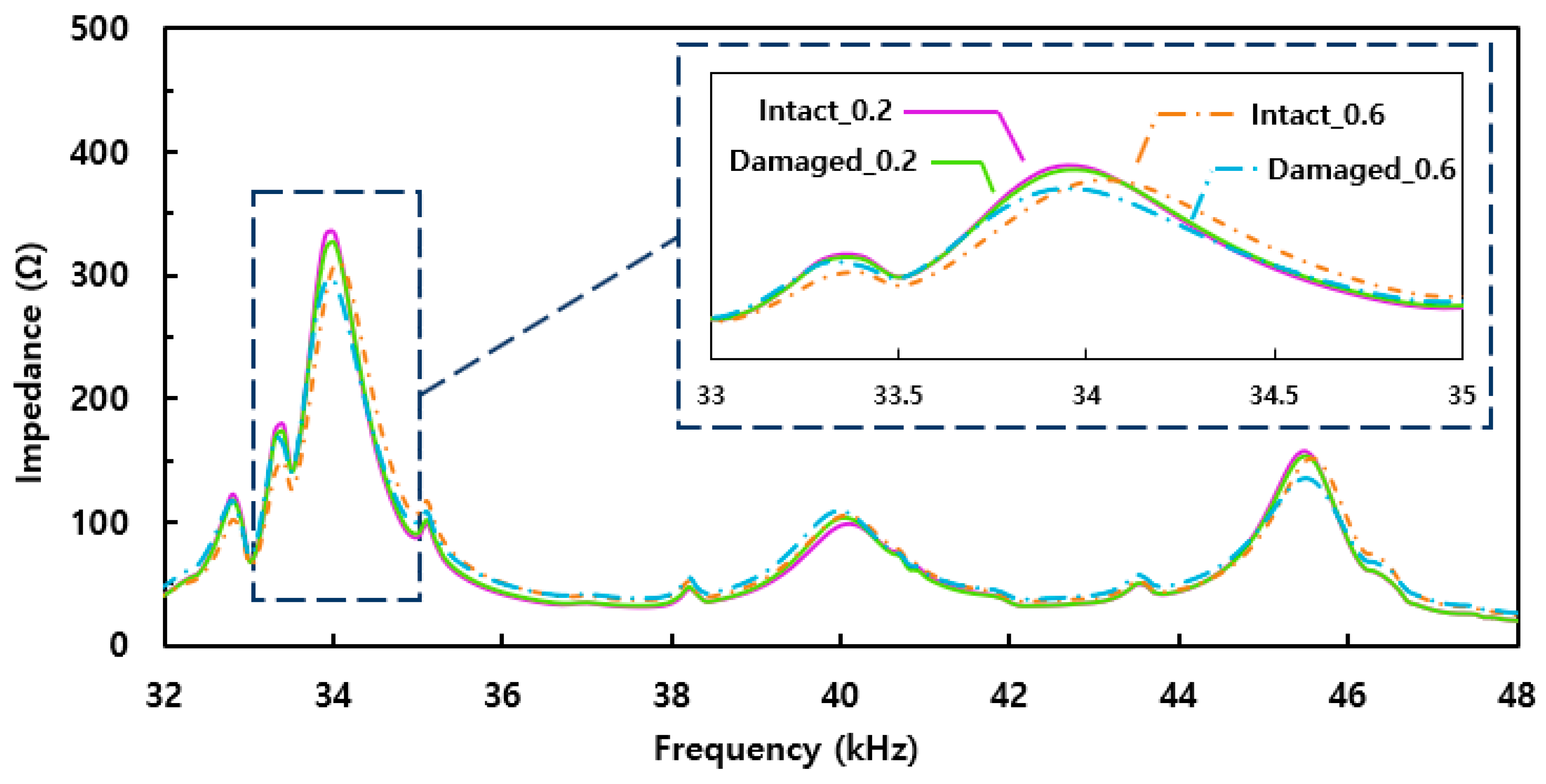
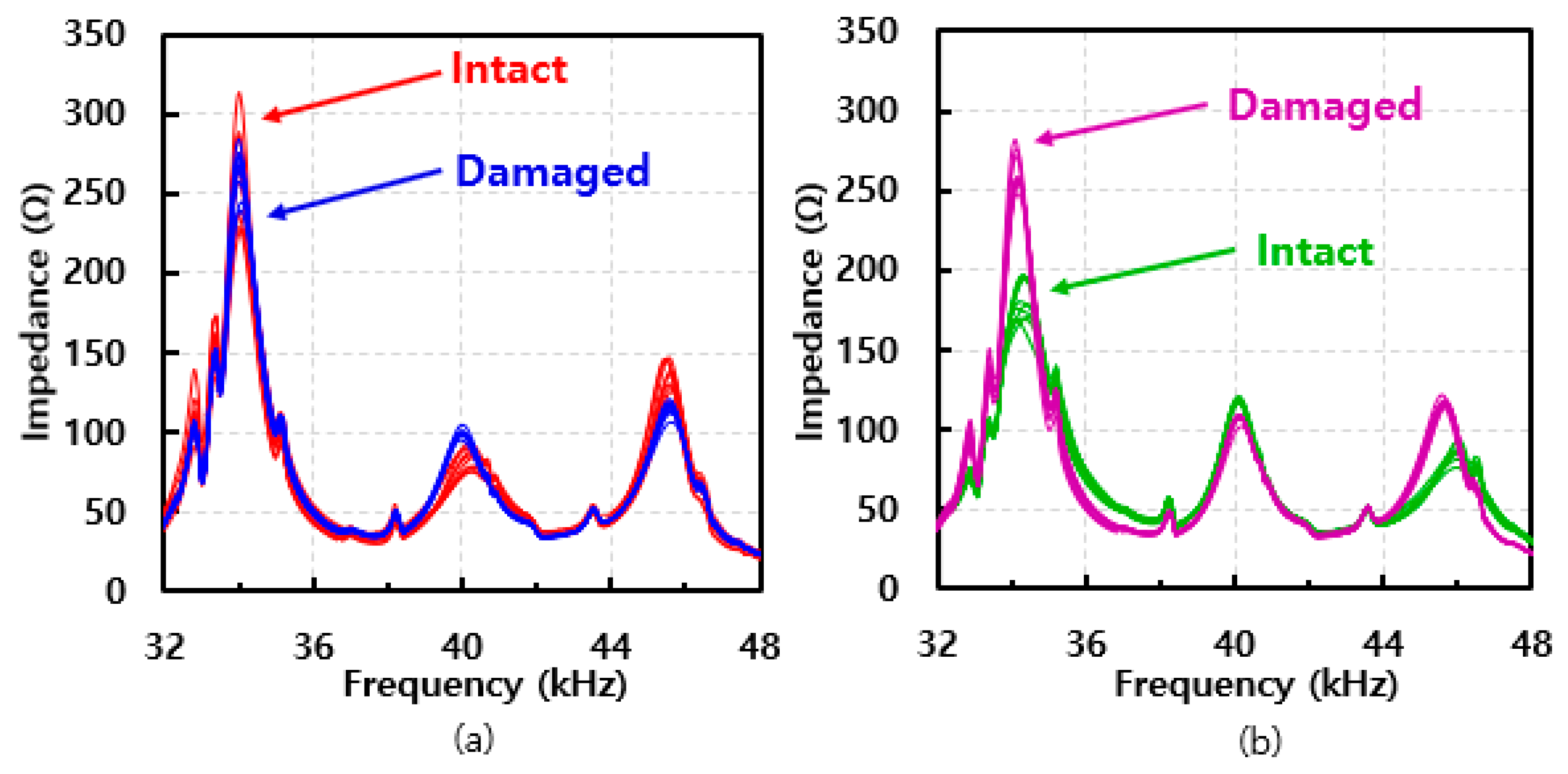
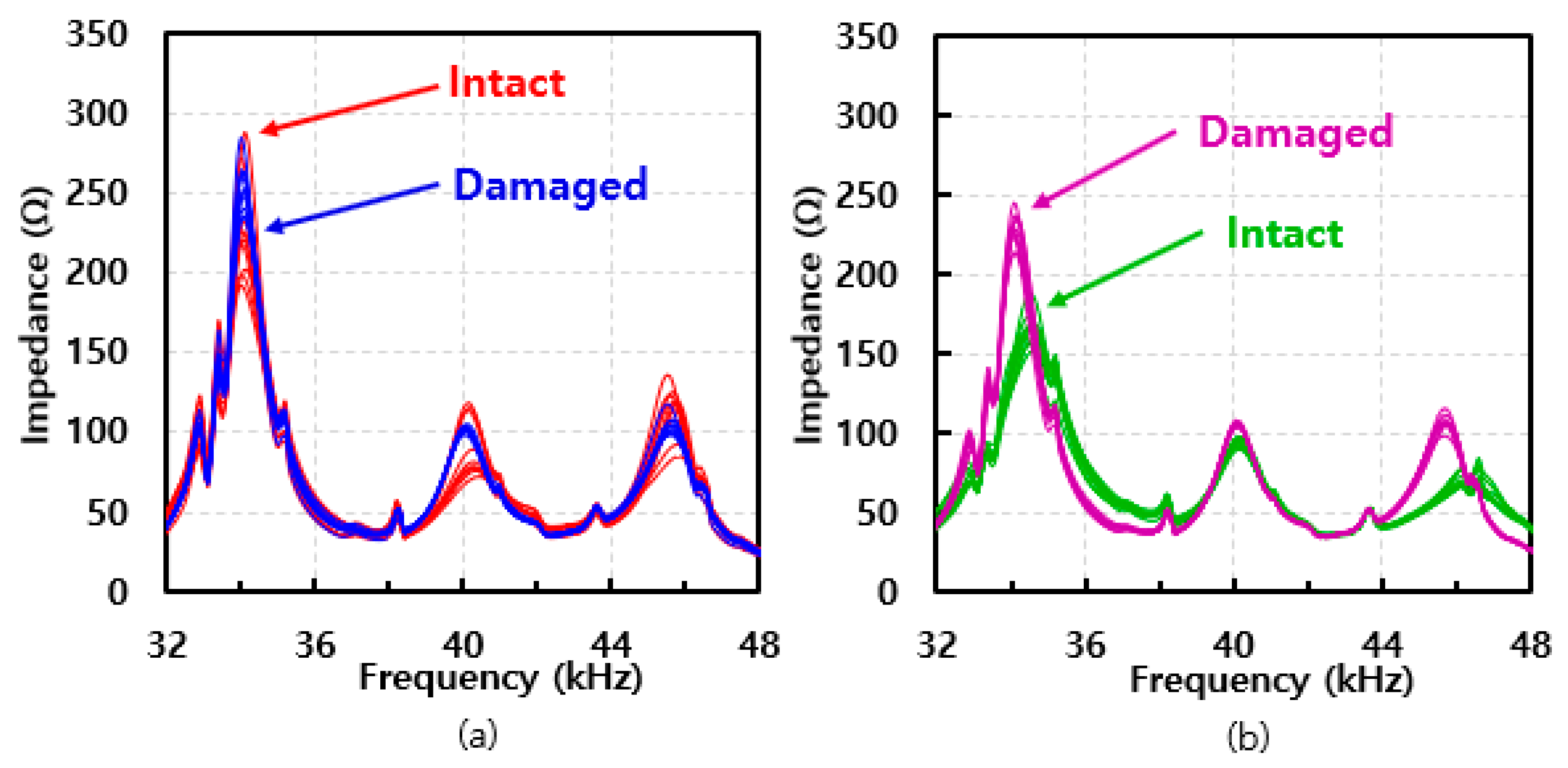

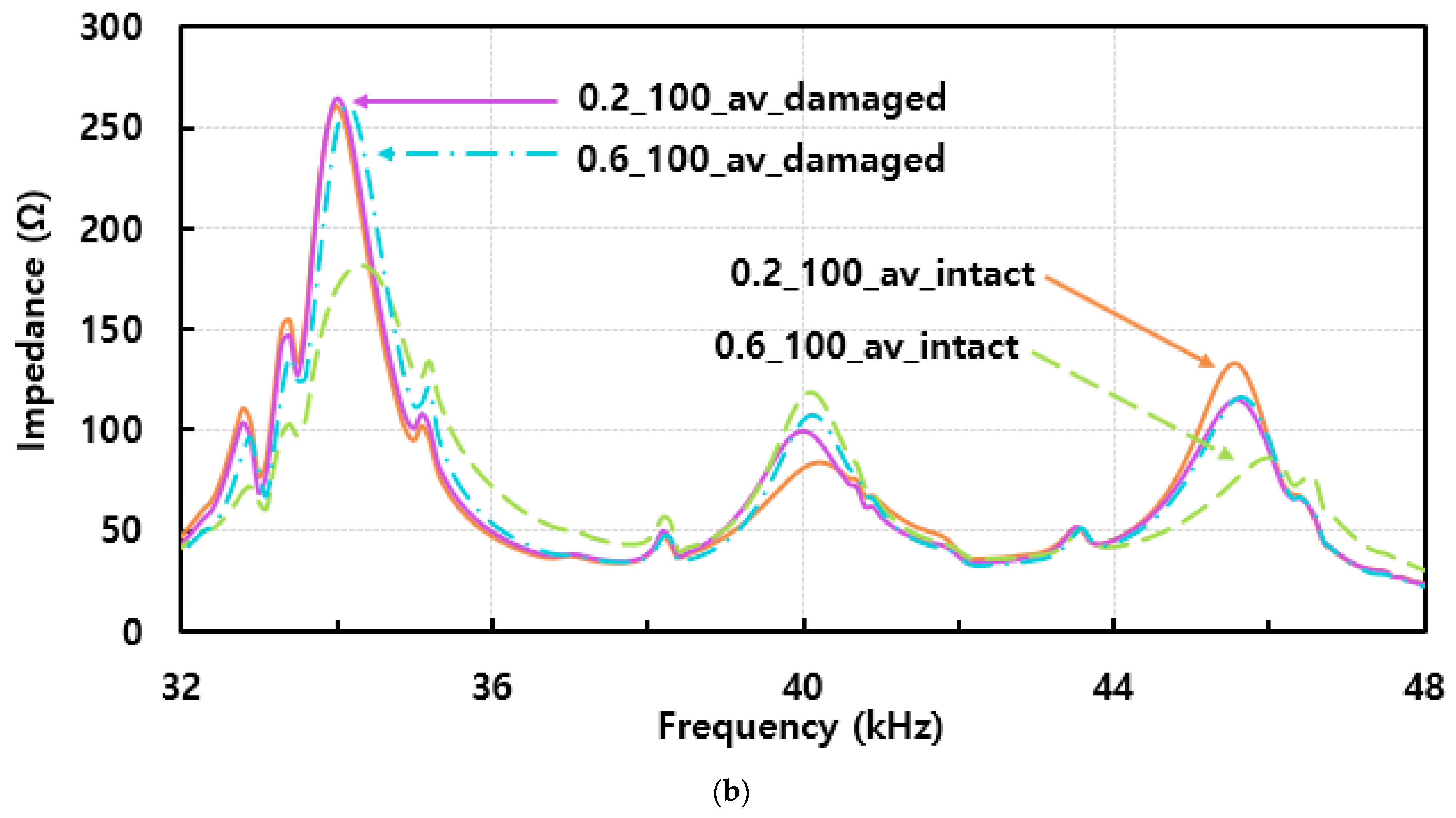

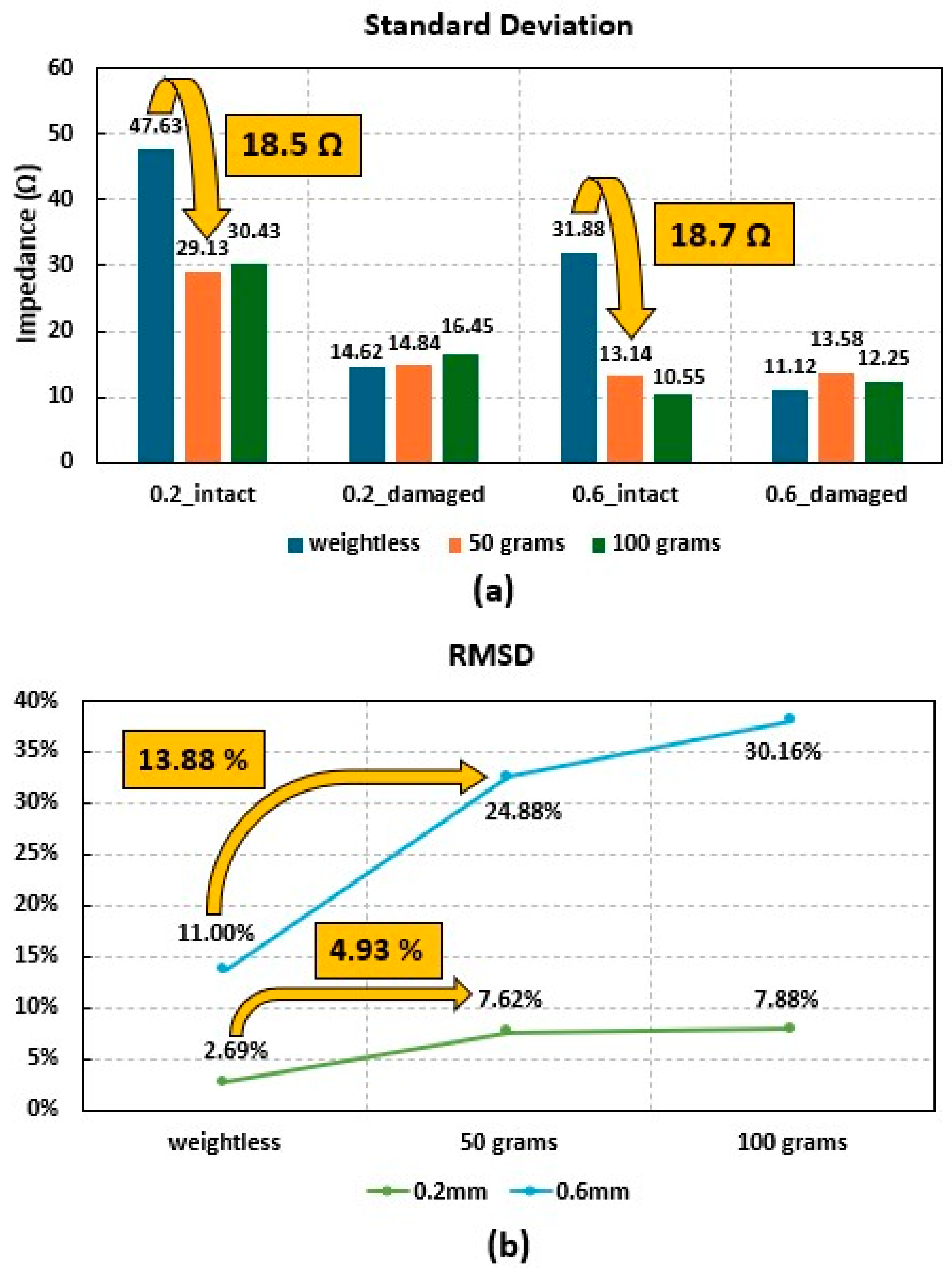
Disclaimer/Publisher’s Note: The statements, opinions and data contained in all publications are solely those of the individual author(s) and contributor(s) and not of MDPI and/or the editor(s). MDPI and/or the editor(s) disclaim responsibility for any injury to people or property resulting from any ideas, methods, instructions or products referred to in the content. |
© 2024 by the authors. Licensee MDPI, Basel, Switzerland. This article is an open access article distributed under the terms and conditions of the Creative Commons Attribution (CC BY) license (https://creativecommons.org/licenses/by/4.0/).
Share and Cite
Choi, H.-W.; Na, W.S. Effect of Different Weight on the Movable PZT Device on the Damage Detection Performance of Electromechanical Impedance Technique. Electronics 2024, 13, 2589. https://doi.org/10.3390/electronics13132589
Choi H-W, Na WS. Effect of Different Weight on the Movable PZT Device on the Damage Detection Performance of Electromechanical Impedance Technique. Electronics. 2024; 13(13):2589. https://doi.org/10.3390/electronics13132589
Chicago/Turabian StyleChoi, Hee-Wook, and Wongi S. Na. 2024. "Effect of Different Weight on the Movable PZT Device on the Damage Detection Performance of Electromechanical Impedance Technique" Electronics 13, no. 13: 2589. https://doi.org/10.3390/electronics13132589
APA StyleChoi, H.-W., & Na, W. S. (2024). Effect of Different Weight on the Movable PZT Device on the Damage Detection Performance of Electromechanical Impedance Technique. Electronics, 13(13), 2589. https://doi.org/10.3390/electronics13132589



